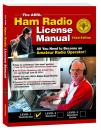 |
‘Wired telegraph is a kind of a very, very long cat. You pull his tail in New York and his head is meowing in Los Angeles. Radio operates exactly the same way, the only difference is that there is no cat.’ |
Spring, 2018
This class aims to prepare students for the technician class amateur radio licensing exam, with emphasis on demonstrating what you could do once you get the license. It was created to enable students who are taking EE123 (Digital Signal Processing) to get credit for the extra work of obtaining a ham license, which is necessary for the labs and projects. However, this class welcomes ANYONE interested in studying for the test and taking it.
Prerequisites: None!
FAQ:
Q: I'm a ______ major. Is this class for me? A: Yes!
Q: How many units should I take? A: 1 unit for attending the 7 lectures and taking the test. 2 units if you are interested in doing a ham related project (Requires instructor permission)
Q: I'm a graduate student, can I take the class? A: Absolutely! but please register to EE298
Q: Can I audit the class? A: Of Course!
Instructor
Michael (Miki) Lustig
506 Cory Hall
(510) 643-9338
mlustig@eecs.berkeley.edu
Class Time and Location
Weekly lectures,
Wednesdays 6:30pm-8:30pm Cory 521
Licensing Exam
TBD
 Technician Ham Radio License Manual 21$ Amazon
Technician Ham Radio License Manual 21$ Amazon
ham Radio
From ARRL: Amateur Radio (Ham Radio) is a popular hobby and service in which licensed Amateur Radio operators (hams) operate communications equipment. Although Amateur Radio operators get involved for many reasons, they all have in common a basic knowledge of radio technology and operating principles, and pass an examination for the FCC license to operate on radio frequencies known as the “Amateur Bands.”. These bands are radio frequencies reserved by the Federal Communications Commission (FCC) for use by ham radio operators.
The role of amateur radio has obviously changed with the presence of the internet. Remarkably, amateur radio today offers unique opportunities and capabilities due to its independence on commercial infrastructure. For example, it is a legal ground for hands-on experimenting with wireless communication technology and it allows communication in emergencies and from remote areas.
What can you do as a ham?
Talk to people (near and far)
Build stuff (amps, sdr’s, antennas, receivers)
Emergency communications (emcom)
First person view (FPV) vehicles (drones) at much higher power
Hit satellites, moon, meteors, airplanes (with radio waves! … not something else)
Digital communication with Automatic Positioning and Reporting System, packet radio
Use Repeaters covering bay-area, California and the United States, mesh networks
Chapters covered in class
Radio and Signals Fundamentals
Electricity Components and Circuits
Propagation, Antennas and Feed Lines
Amateur Radio Equipment
Communication with Other Hams
Licensing and Regulations
Operating Regulations
safety
Links
Earth-Moon-Earth communications: Moon Bouncing, Easy moonbouncing presentation
Aircraft Scattering Communications by bouncing off radio waves from airplanes